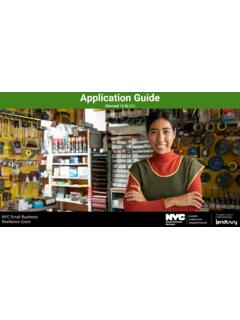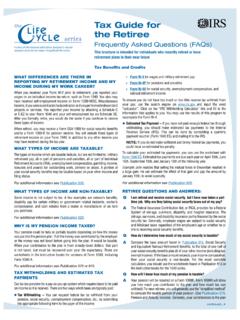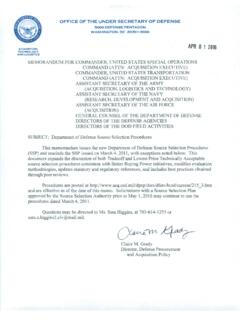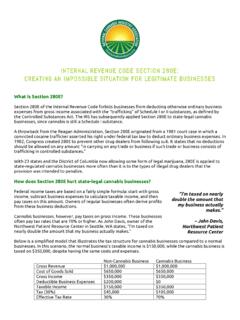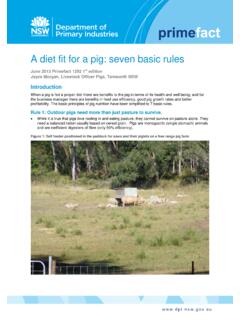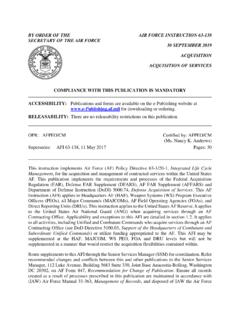Transcription of Note: The draft you are looking for begins on the next ...
1 Note: The draft you are looking for begins on the next page. Caution: draft NOT FOR FILING This is an early release draft of an IRS tax form, instructions , or publication, which the IRS is providing for your information. Do not file draft forms and do not rely on draft forms, instructions , and publications for filing. We do not release draft forms until we believe we have incorporated all changes (except when explicitly stated on this coversheet). However, unexpected issues occasionally arise, or legislation is passed in this case, we will post a new draft of the form to alert users that changes were made to the previously posted draft . Thus, there are never any changes to the last posted draft of a form and the final revision of the form. Forms and instructions generally are subject to OMB approval before they can be officially released, so we post only drafts of them until they are approved. Drafts of instructions and publications usually have some changes before their final release.
2 Early release drafts are at and remain there after the final release is posted at All information about all forms, instructions , and pubs is at Almost every form and publication has a page on with a friendly shortcut. For example, the Form 1040 page is at ; the Pub. 501 page is at ; the Form W-4 page is at ; and the Schedule A (Form 1040/SR) page is at If typing in a link above instead of clicking on it, be sure to type the link into the address bar of your browser, not a Search box. If you wish, you can submit comments to the IRS about draft or final forms, instructions , or publications at Include NTF followed by the form number (for example, NTF1040 or NTFW4 , etc.) in the body of the message to route your message properly. We cannot respond to all comments due to the high volume we receive and may not be able to consider many suggestions until the subsequent revision of the product, but we will review each routed message.
3 If you have comments on reducing paperwork and respondent (filer) burden, with respect to draft or final forms, please respond to the relevant information collection through the Federal Register process; for more info, click here. March 10, 2023 draft AS OF2022 instructions for Form 8995 Qualified business Income Deduction Simplified ComputationDepartment of the TreasuryInternal Revenue ServiceSection references are to the Internal Revenue Code unless otherwise DevelopmentsFor the latest information about developments related to Form 8995 and its instructions , such as legislation enacted after they were published, go to s NewTaxable income limitation adjustments. Taxable income limitations are adjusted for inflation and increased. The married filing separately income limitation amount is the same as the Single income limitation amount for the 2022 tax status name changed to qualifying surviving spouse.
4 The filing status qualifying widow(er) is now called qualifying surviving spouse. The rules for the filing status have not changed. The same rules that applied for qualifying surviving widow(er) apply to qualifying surviving method to track losses or deductions suspended by oth-er provisions. A worksheet is added to provide a reasonable method to track and compute your previously disallowed losses or deductions to be included in your qualified business income deduction calculation for the year allowed. A new row has been included for the 2022 suspended and allowed losses. See Tracking Losses or Deductions Suspended by Other Provisions, InstructionsPurpose of FormUse Form 8995 to figure your qualified business income (QBI) deduction. Individual taxpayers and some trusts and estates may be entitled to a deduction of up to 20% of their net QBI from a trade or business , including income from a pass-through entity, but not from a C corporation, plus 20% of qualified real estate investment trust (REIT) dividends and qualified publicly traded partnership (PTP) income.
5 However, your total QBI deduction is limited to 20% of your taxable income, calculated before the QBI deduction, minus net capital Can Take the DeductionIndividuals and eligible estates and trusts that have QBI use Form 8995 to figure the QBI deduction if: You have QBI, qualified REIT dividends, or qualified PTP income or loss (all defined later); and Your 2022 taxable income before your QBI deduction is less than or equal to $170,050 if single, married filing separately, head of household, qualifying surviving spouse, or are a trust or estate, or $340,100 if married filing jointly; and You aren t a patron in a specified agricultural or horticultural , use Form 8995-A, Qualified business Income Deduction, to figure your QBI corporations and partnerships. S corporations and partnerships aren t eligible for the deduction, but must pass through to their shareholders or partners the necessary information on an attachment to Schedule K-1.
6 See the instructions for Form 1120-S, Income Tax Return for an S Corporation, and Form 1065, Return of Partnership Cooperatives aren t eligible for the deduction. Instead, cooperatives must provide the necessary information to their patrons on Form 1099-PATR or an attachment to help eligible patrons figure their deduction. Certain agricultural or horticultural cooperatives may qualify for a deduction under section 199A(g). See the instructions for Form 1120-C, Income Tax Return for Cooperative Associations, for rules applicable to agricultural and horticultural and trusts. To the extent that a grantor or another person is treated as owning all or part of a trust or estate, the owner will compute its QBI deduction for the portion owned as if section 199A items had been received directly by the owner. Generally, a non-grantor trust or estate may either claim the QBI deduction or provide information to their beneficiaries.
7 In determining the QBI deduction or the information that must be provided to beneficiaries, the estate or trust allocates section 199A items based on the relative proportion of the estate's or trust's distributable net income (DNI) for the tax year distributed (or required to be distributed) to the beneficiary or retained by the estate or trust. If the estate or trust has no DNI for the tax year, section 199A items are allocated entirely to the estate or estates and trusts may compute their own QBI deduction, to the extent section 199A items are allocable to the estate or trust, section 199A items allocated to beneficiaries aren t includible in the estate s or trust s QBI deduction computation. See the instructions for Form 1041, Income Tax Return for Estates and small business Trusts (ESBT). An ESBT must compute the QBI deduction separately for the S and non-S portions of the trust. The Form 8995 used to compute the S portion s QBI deduction must be attached as a PDF to the ESBT tax worksheet filed with Form 1041.
8 When attached to the ESBT tax worksheet, the trust must show that the information is applicable to the S portion only, by writing ESBT in the top margin of the Form 8995. See the instructions for Form Your Qualified Trades or BusinessesYour qualified trades and businesses include your domestic trades or businesses for which you re allowed a deduction for ordinary and necessary business expenses under section 162. However, trades or businesses conducted by corporations and the performance of services as an employee aren t qualified trades or businesses. Generally, specified service trades or businesses (SSTBs) aren t qualified trades or businesses. However, all or a part of the SSTB may be a qualified trade or business if your taxable income is at or below the threshold or within the phase-in provided in section 162, an activity qualifies as a trade or business if your primary purpose for engaging in the activity is for income or profit and you re involved in the activity with continuity and purposes of section 199A, if you own an interest in a pass-through entity, the trade or business determination is made Mar 9, 2023 Cat.
9 No. 69662 SMarch 10, 2023 draft AS OFat the entity level. Material participation under section 469 isn t required to qualify for the QBI deduction. Eligible taxpayers with income from a trade or business may be entitled to the QBI deduction if they otherwise satisfy the requirements of section ownership and rental of real property may constitute a trade or business if it meets the standard described above. Also, Rev. Proc. 2019-38 provides a safe harbor under which a rental real estate enterprise will be treated as a trade or business for purposes of the QBI deduction. Rental real estate that doesn t meet the requirements of the safe harbor may still be treated as a trade or business for purposes of the QBI deduction if it s a section 162 trade or rental or licensing of property to a commonly controlled trade or business operated by an individual or a pass-through entity is considered a trade or business under section performed as an employee excluded from quali-fied trades or businesses.
10 The trade or business of performing services as an employee isn t a trade or business for purposes of section 199A. Therefore, any amounts reported on Form W-2, box 1, other than amounts reported in box 1 if Statutory Employee on Form W-2, box 13, is checked, aren t QBI. If you were previously an employee of a business and continue to provide substantially the same services to that business after you re no longer treated as an employee, there is a presumption that you re providing services as an employee for purposes of section 199A for the 3-year period after ceasing to be an employee. You can rebut this presumption on notice from the IRS by providing records such as contracts or partnership agreements that corroborate your status as a more information on if you re an employee or an independent contractor, see Pub. 15-A, Employer s Supplemental Tax Guide, and Pub. 1779, Independent Contractor or excluded from your qualified trades or businesses.










